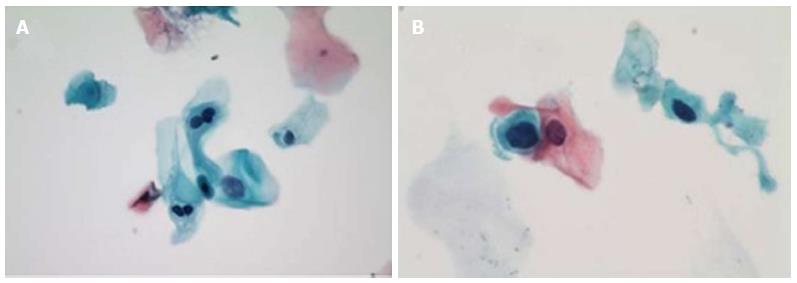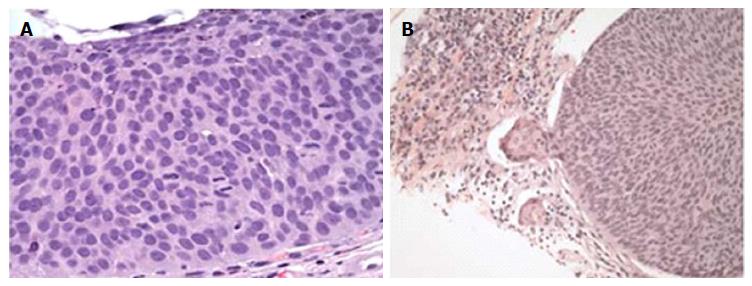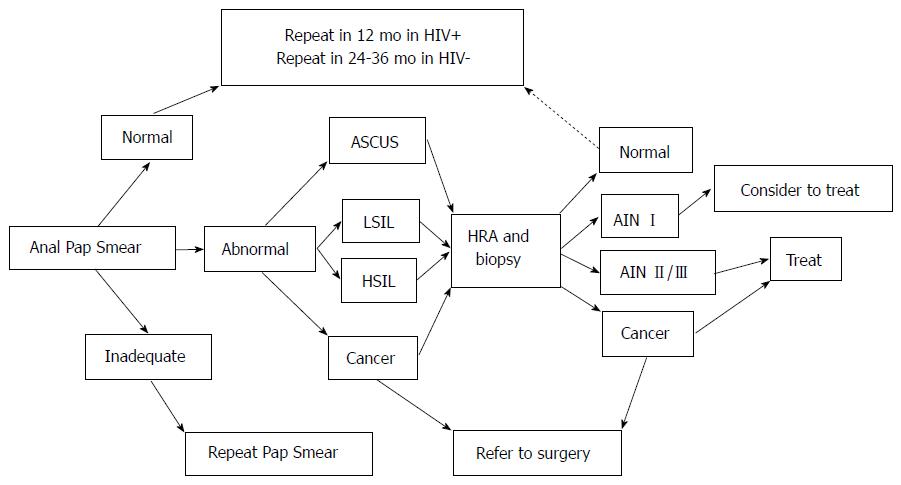Copyright
©The Author(s) 2017.
World J Gastrointest Oncol. Feb 15, 2017; 9(2): 50-61
Published online Feb 15, 2017. doi: 10.4251/wjgo.v9.i2.50
Published online Feb 15, 2017. doi: 10.4251/wjgo.v9.i2.50
Figure 1 Cytology of anal intraepithelial lesions.
A: LSIL, with representative binucleate hyperchromatic cells (koilocytes) and nuclear enlargement (Papanicolaou stain, original magnification × 400); B: HSIL, with representative markedly increased nuclear to cytoplasmis ratio as comparted to LSIL at left (Papanicolaou stain, oil immersion, original magnification × 1000). Reproduced with permission[85]. LSIL: Low grade squamous intraepithelial lesions; HSIL: High grade squamous intraepithelial lesions.
Figure 2 High-resolution anoscopy of representative examples of anal intraepithelial lesions.
A: Low grade AIN lesion after acetic acid application with representative acetowhitening; B: Low grade AIN lesion after application of Lugol’s iodine with brown area representing normal uptake by glycogenated cells, and “mustard” colored area representing negative uptake and suggestive of dysplasia; C: High grade AIN seen after application of acetic acid and the dense acetowhite change; D: High grade AIN with concern for invasion; E: External/perianal high grade AIN after application of acetic acid; F: High grade AIN with concern for invasion. Reproduced with permission[85]. AIN: Anal intraepithelial neoplasia.
Figure 3 Histologic examples of high grade anal intraepithelial neoplasia, hematoxylin and eosin stain.
A: High grade AIN as demonstrated by nuclear pleomorphism, numerous mitoses and no maturation of the epithelium (original magnification × 400); B: Microinvasion of a high grade AIN demonstrated by a budding off of atypical cells with paradoxical maturation and a marked inflammatory response (original magnification × 200). Reproduced with permission[85]. AIN: Anal intraepithelial neoplasia.
Figure 4 Algorithm for diagnosis, treatment and surveillance of anal intraepithelial neoplasia.
Adapted from Palefsky and Rubin, 2009[86]. ASCUS: Atypical squamous cells of undetermined significance; LSIL: Low-grade squamous intraepithelial lesion; HSIL: High-grade squamous intraepithelial lesion; AIN: Anal intraepithelial neoplasia.
- Citation: Roberts JR, Siekas LL, Kaz AM. Anal intraepithelial neoplasia: A review of diagnosis and management. World J Gastrointest Oncol 2017; 9(2): 50-61
- URL: https://www.wjgnet.com/1948-5204/full/v9/i2/50.htm
- DOI: https://dx.doi.org/10.4251/wjgo.v9.i2.50












